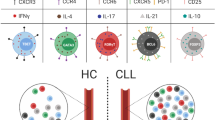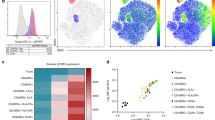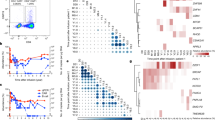Abstract
The tyrosine kinase inhibitor dasatinib exerts immunosuppressive effects on T-cells and NK-cells in vitro. However, in some dasatinib-treated leukemia patients, clonal lymphocytosis with large granular lymphocyte (LGL) morphology develops, and this is associated with enhanced therapeutic responses. To elucidate the mechanistic basis for this paradoxical observation, we conducted detailed phenotypic and functional analyses of T-cell and NK-cell populations from 25 dasatinib-treated leukemia patients. All tested patients with LGL expansions (15/16) were cytomegalovirus (CMV) immunoglobulin (IgG) seropositive with high frequencies of CMV-specific CD8+ T-cells; 5/16 LGL patients also experienced symptomatic CMV reactivation during dasatinib therapy. Expanded T-cell and NK-cell populations exhibited late differentiated (CD27−CD57+) phenotypes; this was associated with a predisposition to apoptosis within the T-cell compartment and impaired NK-cell cytotoxicity. Only 3/9 non-LGL patients were CMV IgG seropositive. Dasatinib inhibited in vitro lymphocyte functions, similarly in LGL patients and controls. Notably, distinct CD8high and CD8low T-cell subsets were observed in LGL patients; this phenotypic dichotomy was also apparent in CMV-specific CD8+ T-cell populations, and exhibited features consistent with antigen-driven activation. In addition, plasma levels of IP-10, IL-6, monokine induced by interferon-γ and interleukin-2R were significantly increased in LGL patients. These data provide evidence that dasatinib-associated LGL expansion is linked to CMV reactivation and suggest a potential mechanism for this phenomenon.
This is a preview of subscription content, access via your institution
Access options
Subscribe to this journal
Receive 12 print issues and online access
$259.00 per year
only $21.58 per issue
Buy this article
- Purchase on Springer Link
- Instant access to full article PDF
Prices may be subject to local taxes which are calculated during checkout




Similar content being viewed by others
References
Druker BJ, Guilhot F, O’Brien SG, Gathmann I, Kantarjian H, Gattermann N et al. Five-year follow-up of patients receiving imatinib for chronic myeloid leukemia. N Engl J Med 2006; 355: 2408–2417.
Kantarjian HM, Giles F, Gattermann N, Bhalla K, Alimena G, Palandri F et al. Nilotinib (formerly AMN107), a highly selective BCR-ABL tyrosine kinase inhibitor, is effective in patients with Philadelphia chromosome-positive chronic myelogenous leukemia in chronic phase following imatinib resistance and intolerance. Blood 2007; 110: 3540–3546.
Hochhaus A, Baccarani M, Deininger M, Apperley JF, Lipton JH, Goldberg SL et al. Dasatinib induces durable cytogenetic responses in patients with chronic myelogenous leukemia in chronic phase with resistance or intolerance to imatinib. Leukemia 2008; 22: 1200–1206.
Rix U, Hantschel O, Durnberger G, Remsing Rix LL, Planyavsky M, Fernbach NV et al. Chemical proteomic profiles of the BCR-ABL inhibitors imatinib, nilotinib, and dasatinib reveal novel kinase and nonkinase targets. Blood 2007; 110: 4055–4063.
Bantscheff M, Eberhard D, Abraham Y, Bastuck S, Boesche M, Hobson S et al. Quantitative chemical proteomics reveals mechanisms of action of clinical ABL kinase inhibitors. Nat Biotechnol 2007; 25: 1035–1044.
Schade AE, Schieven GL, Townsend R, Jankowska AM, Susulic V, Zhang R et al. Dasatinib, a small-molecule protein tyrosine kinase inhibitor, inhibits T-cell activation and proliferation. Blood 2008; 111: 1366–1377.
Weichsel R, Dix C, Wooldridge L, Clement M, Fenton-May A, Sewell AK et al. Profound inhibition of antigen-specific T-cell effector functions by dasatinib. Clin Cancer Res 2008; 14: 2484–2491.
Fei F, Yu Y, Schmitt A, Rojewski MT, Chen B, Greiner J et al. Dasatinib exerts an immunosuppressive effect on CD8+ T cells specific for viral and leukemia antigens. Exp Hematol 2008; 36: 1297–1308.
Fraser CK, Blake SJ, Diener KR, Lyons AB, Brown MP, Hughes TP et al. Dasatinib inhibits recombinant viral antigen-specific murine CD4+ and CD8+ T-cell responses and NK-cell cytolytic activity in vitro and in vivo. Exp Hematol 2009; 37: 256–265.
Seggewiss R, Lore K, Greiner E, Magnusson MK, Price DA, Douek DC et al. Imatinib inhibits T-cell receptor-mediated T-cell proliferation and activation in a dose-dependent manner. Blood 2005; 105: 2473–2479.
Chen J, Schmitt A, Chen B, Rojewski M, Rubeler V, Fei F et al. Nilotinib hampers the proliferation and function of CD8+ T lymphocytes through inhibition of T cell receptor signalling. J Cell Mol Med 2008; 12: 2107–2118.
Blake SJ, Lyons AB, Hughes TP . Nilotinib inhibits the Src-family kinase LCK and T-cell function in vitro. J Cell Mol Med 2009; 13: 599–601.
Sillaber C, Herrmann H, Bennett K, Rix U, Baumgartner C, Bohm A et al. Immunosuppression and atypical infections in CML patients treated with dasatinib at 140 mg daily. Eur J Clin Invest 2009; 39: 1098–1109.
Kantarjian H, Shah NP, Hochhaus A, Cortes J, Shah S, Ayala M et al. Dasatinib versus imatinib in newly diagnosed chronic-phase chronic myeloid leukemia. N Engl J Med 2010; 362: 2260–2270.
Mustjoki S, Ekblom M, Arstila TP, Dybedal I, Epling-Burnette PK, Guilhot F et al. Clonal expansion of T/NK-cells during tyrosine kinase inhibitor dasatinib therapy. Leukemia 2009; 23: 1398–1405.
Kim DH, Kamel-Reid S, Chang H, Sutherland R, Jung CW, Kim HJ et al. Natural killer or natural killer/T cell lineage large granular lymphocytosis associated with dasatinib therapy for Philadelphia chromosome positive leukemia. Haematologica 2009; 94: 135–139.
Kreutzman A, Juvonen V, Kairisto V, Ekblom M, Stenke L, Seggewiss R et al. Mono/oligoclonal T and NK cells are common in chronic myeloid leukemia patients at diagnosis and expand during dasatinib therapy. Blood 2010; 116: 772–782.
Brave M, Goodman V, Kaminskas E, Farrell A, Timmer W, Pope S et al. Sprycel for chronic myeloid leukemia and Philadelphia chromosome-positive acute lymphoblastic leukemia resistant to or intolerant of imatinib mesylate. Clin Cancer Res 2008; 14: 352–359.
Lombardo LJ, Lee FY, Chen P, Norris D, Barrish JC, Behnia K et al. Discovery of N-(2-chloro-6-methyl- phenyl)-2-(6-(4-(2-hydroxyethyl)- piperazin-1-yl)-2-methylpyrimidin-4- ylamino)thiazole-5-carboxamide (BMS-354825), a dual Src/Abl kinase inhibitor with potent antitumor activity in preclinical assays. J Med Chem 2004; 47: 6658–6661.
Price DA, Brenchley JM, Ruff LE, Betts MR, Hill BJ, Roederer M et al. Avidity for antigen shapes clonal dominance in CD8+ T cell populations specific for persistent DNA viruses. J Exp Med 2005; 202: 1349–1361.
Valiante NM, Rengaraju M, Trinchieri G . Role of the production of natural killer cell stimulatory factor (NKSF/IL-12) in the ability of B cell lines to stimulate T and NK cell proliferation. Cell Immunol 1992; 145: 187–198.
Brown CE, Wright CL, Naranjo A, Vishwanath RP, Chang WC, Olivares S et al. Biophotonic cytotoxicity assay for high-throughput screening of cytolytic killing. J Immunol Methods 2005; 297: 39–52.
Douek DC, Betts MR, Brenchley JM, Hill BJ, Ambrozak DR, Ngai KL et al. A novel approach to the analysis of specificity, clonality, and frequency of HIV-specific T cell responses reveals a potential mechanism for control of viral escape. J Immunol 2002; 168: 3099–3104.
Lefranc MP, Pommie C, Ruiz M, Giudicelli V, Foulquier E, Truong L et al. IMGT unique numbering for immunoglobulin and T cell receptor variable domains and Ig superfamily V-like domains. Dev Comp Immunol 2003; 27: 55–77.
Wlodarski MW, Nearman Z, Jankowska A, Babel N, Powers J, Leahy P et al. Phenotypic differences between healthy effector CTL and leukemic LGL cells support the notion of antigen-triggered clonal transformation in T-LGL leukemia. J Leukoc Biol 2008; 83: 589–601.
Lissina A, Ladell K, Skowera A, Clement M, Edwards E, Seggewiss R et al. Protein kinase inhibitors substantially improve the physical detection of T-cells with peptide-MHC tetramers. J Immunol Methods 2009; 340: 11–24.
Appay V, van Lier RA, Sallusto F, Roederer M . Phenotype and function of human T lymphocyte subsets: consensus and issues. Cytometry A 2008; 73: 975–983.
Sun JC, Beilke JN, Lanier LL . Adaptive immune features of natural killer cells. Nature 2009; 457: 557–561.
Cooper MA, Elliott JM, Keyel PA, Yang L, Carrero JA, Yokoyama WM . Cytokine-induced memory-like natural killer cells. Proc Natl Acad Sci USA 2009; 106: 1915–1919.
Shah NP, Kantarjian HM, Kim DW, Rea D, Dorlhiac-Llacer PE, Milone JH et al. Intermittent target inhibition with dasatinib 100 mg once daily preserves efficacy and improves tolerability in imatinib-resistant and -intolerant chronic-phase chronic myeloid leukemia. J Clin Oncol 2008; 26: 3204–3212.
Rohon P, Porkka K, Mustjoki S . Immunoprofiling of patients with chronic myeloid leukemia at diagnosis and during tyrosine kinase inhibitor therapy. Eur J Haematol 2010; 85: 387–398.
Mohty M, Faucher C, Vey N, Chabannon C, Sainty D, Arnoulet C et al. Features of large granular lymphocytes (LGL) expansion following allogeneic stem cell transplantation: a long-term analysis. Leukemia 2002; 16: 2129–2133.
Rossi D, Franceschetti S, Capello D, De Paoli L, Lunghi M, Conconi A et al. Transient monoclonal expansion of CD8+/CD57+ T-cell large granular lymphocytes after primary cytomegalovirus infection. Am J Hematol 2007; 82: 1103–1105.
Strickler JG, Movahed LA, Gajl-Peczalska KJ, Horwitz CA, Brunning RD, Weiss LM . Oligoclonal T cell receptor gene rearrangements in blood lymphocytes of patients with acute Epstein-Barr virus-induced infectious mononucleosis. J Clin Invest 1990; 86: 1358–1363.
Burrows SR, Khanna R, Burrows JM, Moss DJ . An alloresponse in humans is dominated by cytotoxic T lymphocytes (CTL) cross-reactive with a single Epstein-Barr virus CTL epitope: implications for graft-versus-host disease. J Exp Med 1994; 179: 1155–1161.
Nahill SR, Welsh RM . High frequency of cross-reactive cytotoxic T lymphocytes elicited during the virus-induced polyclonal cytotoxic T lymphocyte response. J Exp Med 1993; 177: 317–327.
Nachbaur D, Bonatti H, Oberaigner W, Eibl B, Kropshofer G, Gastl G et al. Survival after bone marrow transplantation from cytomegalovirus seropositive sibling donors. Lancet 2001; 358: 1157–1159.
Oxenius A, Gunthard HF, Hirschel B, Fidler S, Weber JN, Easterbrook PJ et al. Direct ex vivo analysis reveals distinct phenotypic patterns of HIV-specific CD8(+) T lymphocyte activation in response to therapeutic manipulation of virus load. Eur J Immunol 2001; 31: 1115–1121.
Sylwester AW, Mitchell BL, Edgar JB, Taormina C, Pelte C, Ruchti F et al. Broadly targeted human cytomegalovirus-specific CD4+ and CD8+ T cells dominate the memory compartments of exposed subjects. J Exp Med 2005; 202: 673–685.
Scheinberg P, Melenhorst JJ, Brenchley JM, Hill BJ, Hensel NF, Chattopadhyay PK et al. The transfer of adaptive immunity to CMV during hematopoietic stem cell transplantation is dependent on the specificity and phenotype of CMV-specific T cells in the donor. Blood 2009; 114: 5071–5080.
Schmitz JE, Forman MA, Lifton MA, Concepcion O, Reimann Jr KA, Crumpacker CS et al. Expression of the CD8alpha beta-heterodimer on CD8(+) T lymphocytes in peripheral blood lymphocytes of human immunodeficiency virus- and human immunodeficiency virus+ individuals. Blood 1998; 92: 198–206.
Keir ME, Rosenberg MG, Sandberg JK, Jordan KA, Wiznia A, Nixon DF et al. Generation of CD3+CD8low thymocytes in the HIV type 1-infected thymus. J Immunol 2002; 169: 2788–2796.
Blish CA, Dillon SR, Farr AG, Fink PJ . Anergic CD8+ T cells can persist and function in vivo. J Immunol 1999; 163: 155–164.
Brenchley JM, Karandikar NJ, Betts MR, Ambrozak DR, Hill BJ, Crotty LE et al. Expression of CD57 defines replicative senescence and antigen-induced apoptotic death of CD8+ T cells. Blood 2003; 101: 2711–2720.
Sun Y, Finger C, Alvarez-Vallina L, Cichutek K, Buchholz CJ . Chronic gene delivery of interferon-inducible protein 10 through replication-competent retrovirus vectors suppresses tumor growth. Cancer Gene Ther 2005; 12: 900–912.
Choi SW, Hildebrandt GC, Olkiewicz KM, Hanauer DA, Chaudhary MN, Silva IA et al. CCR1/CCL5 (RANTES) receptor-ligand interactions modulate allogeneic T-cell responses and graft-versus-host disease following stem-cell transplantation. Blood 2007; 110: 3447–3455.
Swa S, Wright H, Thomson J, Reid H, Haig D . Constitutive activation of Lck and Fyn tyrosine kinases in large granular lymphocytes infected with the gamma-herpesvirus agents of malignant catarrhal fever. Immunology 2001; 102: 44–52.
Melenhorst JJ, Scheinberg P, Chattopadhyay PK, Gostick E, Ladell K, Roederer M et al. High avidity myeloid leukemia-associated antigen-specific CD8+ T cells preferentially reside in the bone marrow. Blood 2009; 113: 2238–2244.
Sze DM, Giesajtis G, Brown RD, Raitakari M, Gibson J, Ho J et al. Clonal cytotoxic T cells are expanded in myeloma and reside in the CD8(+)CD57(+)CD28(-) compartment. Blood 2001; 98: 2817–2827.
Epling-Burnette PK, Painter JS, Rollison DE, Ku E, Vendron D, Widen R et al. Prevalence and clinical association of clonal T-cell expansions in myelodysplastic syndrome. Leukemia 2007; 21: 659–667.
Li J, Sze DM, Brown RD, Cowley MJ, Kaplan W, Mo SL et al. Clonal expansions of cytotoxic T cells exist in the blood of patients with Waldenstrom macroglobulinemia but exhibit anergic properties and are eliminated by nucleoside analogue therapy. Blood 2010; 115: 3580–3588.
Acknowledgements
This work was supported in part by the IZKF Würzburg Z-2/27 and Deutsche Forschungsgemeinschaft (DFG) KFO 216 to RS. The Finnish special governmental subsidy for health sciences, research and training, and grants from the Finnish Cancer Societies, Emil Aaltonen Foundation, Academy of Finland, Biomedicum Helsinki Foundation, Finnish Medical Foundation, Blood Disease Foundation, Finnish Association of Haematology, Sigrid Juselius Foundation and KA Johansson Foundation to SM and KP. AK is a Helsinki Biomedical Graduate School PhD student. SM is an Academy of Finland Research Fellow. DAP is a Medical Research Council (UK) Senior Clinical Fellow. The authors thank Michael Zekl for help with the figures and Dr Arne Schäfer for statistical advice. Personnel at the Hematology Research Unit are acknowledged for their expert technical assistance.
Author information
Authors and Affiliations
Corresponding author
Additional information
Supplementary Information accompanies the paper on the Leukemia website
Rights and permissions
About this article
Cite this article
Kreutzman, A., Ladell, K., Koechel, C. et al. Expansion of highly differentiated CD8+ T-cells or NK-cells in patients treated with dasatinib is associated with cytomegalovirus reactivation. Leukemia 25, 1587–1597 (2011). https://doi.org/10.1038/leu.2011.135
Received:
Revised:
Accepted:
Published:
Issue Date:
DOI: https://doi.org/10.1038/leu.2011.135
Keywords
This article is cited by
-
Risk factors and clinical outcomes of cytomegalovirus diseases in hematologic malignancy patients without hematopoietic stem-cell transplantation
Supportive Care in Cancer (2024)
-
BCR::ABL1 tyrosine kinase inhibitors hamper the therapeutic efficacy of blinatumomab in vitro
Journal of Cancer Research and Clinical Oncology (2022)
-
Pivotal Role of Fyn Kinase in Parkinson’s Disease and Levodopa-Induced Dyskinesia: a Novel Therapeutic Target?
Molecular Neurobiology (2021)
-
Innate T-αβ lymphocytes as new immunological components of anti-tumoral “off-target” effects of the tyrosine kinase inhibitor dasatinib
Scientific Reports (2020)
-
Nilotinib treatment induced large granular lymphocyte expansion and maintenance of longitudinal remission in a Philadelphia chromosome-positive acute lymphoblastic leukemia
International Journal of Hematology (2020)



